On Saturday morning I left my home in Cusco, nearly tearing up on the way to the airport at the thought of leaving and not riding down the Avenida de la Cultura again (not until I get back down there, anyway). It is by no means a charming street, it is actually fairly ugly and very noisy, and a few minutes of walking along it makes breathing difficult, not just from the altitude, but rather from the myriad little cars constantly motoring along without regulated emissions. It is funny how you can get attached to a place just because you see it and hear it and smell it and feel it every day for some number of days, and not until you leave and you are abruptly faced with its absence do you realize how much it had really become a part of you. It is like that with Cusco. I was never totally enchanted by the place itself, nor is it necessarily my favorite city, but a bit of it has definitely stuck with me. Somehow I know that I will go back someday. I think that it is just that way with places that really get under your skin.
I finally arrived home late Sunday afternoon. The transit consisted more of waiting around for flights than actually flying, and there was an afternoon in Lima involved, more on that when I get around to it. Luckily nobody seems to enforce carry-on baggage restrictions, since after I checked two stuffed-nearly-to-the-point-of-exploding bags I still had a backpack in similar condition, plus a small purse, and I was lugging around a cajón most of that time.
It is good to be home, but transitions are never easy. I am still getting used to it again. The colors, the rhythm, the flavors, the structures, everything is different and, for the moment, "foreign". I am sure that it will all seem normal again soon, but one thing is for sure: the travel bug in me is alive and well and more restless than ever. I am already itching (no, it is not just the flea(?) bites) to get out and explore again, to see and experience something different. Maybe that is part of why I am making a long drive to Idaho tomorrow, just to turn around and do it again to come back the next day. Maybe there are other reasons, too.
There are a bunch of pictures and some stories that I did not get a chance to share before I left; now that I am back I am hoping to get them up here for you to see, so stay tuned and V, get your comments ready!
Tuesday, June 26, 2007
Thursday, June 21, 2007
Lunch in Tipón
The Huasao trip did not end just like that. Before returning to Cusco we hopped on a minibus to Tipón, the region's cuy capital. Cuy, as you might guess from the first picture, is the Spanish word for guinea pig; a cuyería, in turn, serves fresh roasted cuyes. We figured we might as well give it a try while we are here, and it made for a great outing (beats sitting in a freezing classroom for four hours).

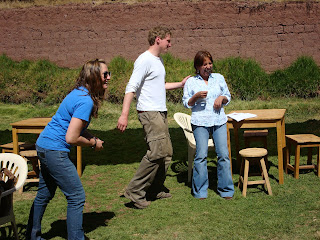 Jeanie aka Shimmy, Timo, and Libia, playing the sapo game while waiting for lunch to be served.
Jeanie aka Shimmy, Timo, and Libia, playing the sapo game while waiting for lunch to be served.

There's the sapo. Beneath him is a drawer with several compartments, each giving a certain number of points to whoever tosses a metal disk into it.
What does it taste like? Honestly, a lot like chicken.

There's the sapo. Beneath him is a drawer with several compartments, each giving a certain number of points to whoever tosses a metal disk into it.
What does it taste like? Honestly, a lot like chicken.
Huasao: fauna and flora
Huasao
Last week in class we were studying Andean medicine, complete with a trip to the market to learn about medicinal plants and a whole day dedicated to the Coca leaf. We also learned a bit about magical-religious medicine, the kind that the shamans practice. Just reading and talking about it in class, though, was not enough. We had to get some real-life experience, so we took a bus down the road to Huasao, where we visited a shaman who reads people's fortunes in Coca leaves. Seriously. My classmate Jeanie, our teacher Libia, my housemate Timo and I made the trip. Jeanie went first, and the poor guy had enough trouble with Spanish as it was (his principal language being Quechua), let alone with crazy Anglo names. For the rest of the day she was known as "Shimmy". When the shaman tried to pronounce her full name, which could be a tongue-twister even for native English-speakers, I was struggling to keep from laughing and would have been fine had I not seen Libia next to me covering her face and shaking with laughter herself. I lost it, and I felt terrible; Libia is sure that he is never going to let her in again. I would love to show you a picture of the room we were in, the walls covered with still-life paintings and images of Catholic saints who overlook numerous ceremonies in which the shaman invokes Pachamana (Mother Earth), but I thought that taking a picture would be terribly disrespectful, especially once I had snickered at the shaman's rendition of Jeanie's full name. It was a good thing that Timo told him that he was from "Holanda" (Spanish for Holland) and not "Utrecht" (Dutch for impossible for a Spanish-speaker to pronounce). Following are a few pictures of Huasao houses.
Monday, June 18, 2007
Machu Picchu: people
The last MP post, I promise. From top to bottom: proof that I was really there (or is that photoshopped?); our entertaining guide Julio, who walked around with an orange flag and a black umbrella, reminding me both of Under the Tuscan Sun and of the Baltimore Orioles; my classmate Jeanie being studious and writing down all the stuff Julio had just taught us; Timo trying out the Incan playground.




Machu Picchu: more plants
I really liked this tree, and when I asked my tour guide, "Iman chay mallqui?" he told me an interesting, if slightly fantastical story about it: where this tree stands now, there was once just a sole wooden post, supposedly used for weaving (something like this, I imagine), and in recent years (I do not know just how recent) this post just started sprouting, and grew into this beautiful pisonay tree.
And yep, those are forget-me-nots.



And yep, those are forget-me-nots.
Machu Picchu: plants
"Old Mountain"
...is the literal meaning of the name Machu Picchu. It's not quite as catchy in English, though. I made the overpriced journey by train to the famed Inca city on Saturday. Here is the obligatory snapshot from the mirador just inside the entrance. I screwed up and got some of the terrace I was standing on in the corner there; I guess that makes it unique and proves that it is not a postcard.

Thursday, June 14, 2007
Just an afternoon in Cusco
Yesterday afternoon I walked up to the San Cristóbal church with my classmate Jeanie. We did not get to take a look inside, but the views of the city were nice. Those clouds are very rare in Cusco, but they made for some nice pictures. In the plaza next to the church, there was a guy selling handmade necklaces and bracelets. He began speaking to us in English and as soon as he found out we were from the US, he immediately broke into a rant on the evils of capitalism and explained to us that our country is the origin of all the world's problems. He didn't seem to understand that that wasn't the best way to make a friend. The best part was, right after he had been denouncing capitalism, he tried to get us to buy something from him. 
 The second photo was taken from a balcony a couple of streets down the hill from the church. I love those tile roofs. There is a story here, too: while we were enjoying the views of town, we were approached by two Cusco police officers. No, we were not violating the law posted on the sign in the third picture, whose wording was just too funny not to capture on film. Rather, they just wanted to chat, or avoid having to work. Whatever the case, we ended up talking to them for over an hour. It reminded me of the days in Mérida's Plaza Grande, where we would often sit and chat with the local viejitos about just about anything. It was just an afternoon in Cusco, with a reminder of why it is sometimes difficult to be an American in a foreign country, and another, of why I love Latin America.
The second photo was taken from a balcony a couple of streets down the hill from the church. I love those tile roofs. There is a story here, too: while we were enjoying the views of town, we were approached by two Cusco police officers. No, we were not violating the law posted on the sign in the third picture, whose wording was just too funny not to capture on film. Rather, they just wanted to chat, or avoid having to work. Whatever the case, we ended up talking to them for over an hour. It reminded me of the days in Mérida's Plaza Grande, where we would often sit and chat with the local viejitos about just about anything. It was just an afternoon in Cusco, with a reminder of why it is sometimes difficult to be an American in a foreign country, and another, of why I love Latin America.
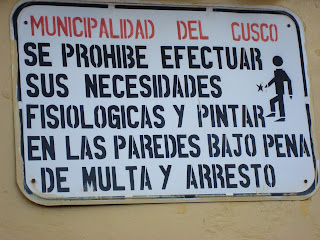
North of Cusco, 4
Saqsaywaman was the last site on our tour, the closest to Cusco. It was already getting dark when we arrived, which was too bad since Saqsaywaman is the largest and probably most interesting of the four sites we visited that day. I am not really sure what it all was, since we did not hire a guide, nor did we stay long enough to really explore it, since it was getting late and we were a little tired of looking at stones anyway, but the views from up there are quite spectacular. Maybe we would have gotten to see more if we hadn't spent so much time taking pictures of trees and llamas...
 Cristo Blanco overlooks the city.
Cristo Blanco overlooks the city.

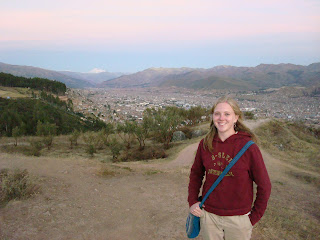 Another view, with the snow-capped mountain which I think is Ausangate.
Another view, with the snow-capped mountain which I think is Ausangate.
Believe it or not, this was the best of five shots.

Oh, there are some Saqsaywaman rocks.
Believe it or not, this was the best of five shots.
Oh, there are some Saqsaywaman rocks.
North of Cusco, 3
North of Cusco, 2
North of Cusco
So Cusco has this silly system where you have to buy a Boleto Turístico, or tourist ticket, that gets you into 15 or 16 sites in and around the city, but it is only good for 10 days. Monday was the last day I could use mine, so after lunch my new friend Timo and I embarked on a marathon tour of four archaelogical sites just north of Cusco.
 This is Tambomachay. It was some sort of ceremonial bath used by the Incas, but I prefer Timo's on-the-fly translation from his Dutch tour guide: "here the Inca man came to the holy spring".
This is Tambomachay. It was some sort of ceremonial bath used by the Incas, but I prefer Timo's on-the-fly translation from his Dutch tour guide: "here the Inca man came to the holy spring".

 This is Pukapukara, quechua for "red fort". Its original use(s) seem to be uncertain: my Lonely Planet guide says something about it maybe being a hunting lodge, while the guide we met at the site told us it was a check point along the Inca trail leading to Cusco city, as well as a sort of meditation center and playground. That's right, the youth would sit on the terrace on top and absorb the magnetic energy which supposedly emanates from this spot, and when they got bored with that, they would go downstairs and toss rocks into a hole in the wall. The guide was very insistent in explaining that it was not a drainage pipe, but very clearly used for sport. Hmm.
This is Pukapukara, quechua for "red fort". Its original use(s) seem to be uncertain: my Lonely Planet guide says something about it maybe being a hunting lodge, while the guide we met at the site told us it was a check point along the Inca trail leading to Cusco city, as well as a sort of meditation center and playground. That's right, the youth would sit on the terrace on top and absorb the magnetic energy which supposedly emanates from this spot, and when they got bored with that, they would go downstairs and toss rocks into a hole in the wall. The guide was very insistent in explaining that it was not a drainage pipe, but very clearly used for sport. Hmm.
Pukapukara also boasts a scale model of Machu Picchu. Who needs the real thing, anyway?
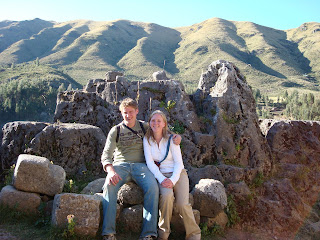
Pukapukara also boasts a scale model of Machu Picchu. Who needs the real thing, anyway?
Wednesday, June 13, 2007
A couple of gems from the market
The neat thing about my culture class here is that my teacher incorporates on-site visits into the course, reminding us that what we are learning is real and alive, not just stagnant words on a piece of paper. This week we are studying Andean medicine, which has roots going back as far as 3000 b.C. and whose principles are very much alive and well in the mentality and practices of people here today.
 Apparently, frog soup cures pretty much everything: headache, tired eyes, anemia, the prostate, asthma, nerves, menopause, and epilepsy. Who'da thunk?
Apparently, frog soup cures pretty much everything: headache, tired eyes, anemia, the prostate, asthma, nerves, menopause, and epilepsy. Who'da thunk?

Sahumerio is a mixture of paper fiber and herbs, used like incense. Here is a selection of sahumerios which, when used properly, promise things like money, love, protection from evil, or even a clean house. If you are looking for a more economical option, I would recommend the all-in-one "siete poderes" (seven powers).
Sahumerio is a mixture of paper fiber and herbs, used like incense. Here is a selection of sahumerios which, when used properly, promise things like money, love, protection from evil, or even a clean house. If you are looking for a more economical option, I would recommend the all-in-one "siete poderes" (seven powers).
Pisac III
Ah, more rocks.
 This was the religious site at Pisac. You can tell from the more refined style, more uniform stones and precise cuts that allowed for construction without caulking.
This was the religious site at Pisac. You can tell from the more refined style, more uniform stones and precise cuts that allowed for construction without caulking.
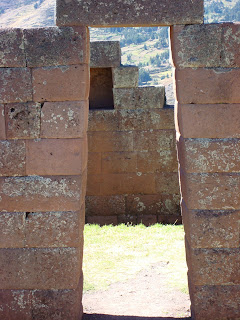

I am pretty sure that that dog has been napping there since the Inca days.

View of Pisac pueblo and countryside from one of the watchtowers.
I am pretty sure that that dog has been napping there since the Inca days.
View of Pisac pueblo and countryside from one of the watchtowers.
Subscribe to:
Posts (Atom)
